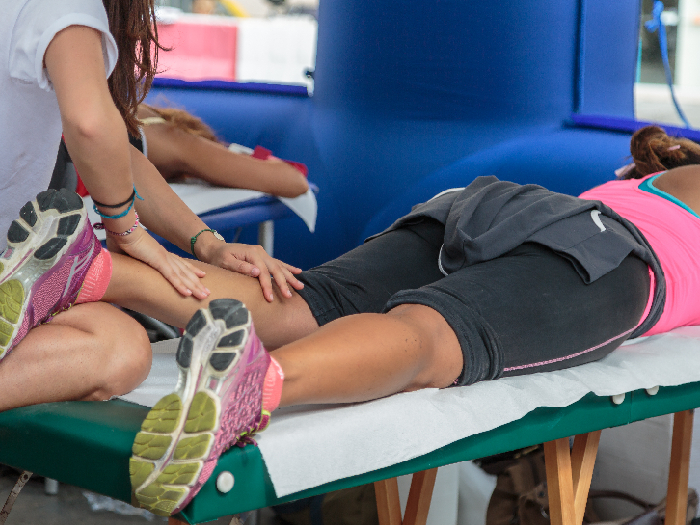A sports massage is a type of massage that is specialized for athletes who exert their muscles more than the average person. While some techniques involved in this massage routine are the same as other forms of massage, sports massage is intended to remove, repair, and prevent injuries from athletic activities.
What is Sports Massage?
Sports massage is a popular training tool for athletes, particularly long-distance runners and professional athletes as it can be both an educational and soothing experience. It targets the soft muscle tissues that are specifically involved in a particular sport and can be performed pre-performance, post-performance, during training, or a rehabilitation period.
As with other forms of massage, this style encourages blood flow and oxygenation to the regions being worked on, increasing flexibility and stimulating the muscle tissue. By manipulating the specific areas relevant to a given sport, this type of massage is more targeted and practitioners must have additional kinesiology and medical knowledge. It is always important to get sports massages from those who have been certified in this delicate and essential massage discipline. [1]

Sports massages help improve flexibility and reduce the chance of injuries. Photo Credit: Shutterstock
Benefits
The primary benefits of a sports massage include its ability to increase flexibility, soothe the nervous system, and improve sleep quality. There are many other physical and psychological benefits of this massage that are anecdotally reported by many athletes.
- Flexibility: By working on the soft muscle tissue and manipulating these areas, a practitioner can loosen tense muscles that prevent a full range of motion and decrease flexibility. This is critical for athletes who want to fully utilize their bodies during their performance. [2]
- Nervous System: Exertion on the same muscle groups can cause muscle spasms and issues with your nervous system. A sports-oriented massage is a way to relax the nerves and prevent discomfort, particularly while sleeping. This can also be beneficial for high-intensity athletes, such as sprinters, as outlined in this study from the Journal of Strength and Conditioning Research. [3]
- Muscle Tension: Tension and muscle soreness are natural following heavy activity, and regular sports massage can help to re-set the body to a relaxed and normal state. This is needed by athletes who regularly ask a lot from their bodies. [4]
- Sleep Quality: Muscle tension and fatigue can be so bad in some cases that it makes it difficult to sleep, despite being physically exhausted. Sports massage is proven to ease sleep disturbances and help the body relax after intense exercise, as explained in this study from the Journal of Bodywork and Movement Therapies. [5]
- Prevent Injury: One of the major purposes of this massage style is reducing the likelihood of injury. By identifying problem spots, areas where more stretching is required, or sensitive muscle groups, a sports massage therapist can help athletes avoid more serious injuries. [6]
- Recovery Time: Many athletes attest that sports massage can speed up recovery time, enabling them to perform again more quickly. Massage can help to stimulate the body’s natural repair processes, which can improve recovery time, but the research on this particular subject is still somewhat lacking. [7]
Sports Massage vs Deep Tissue Massage
Let us take a look at the main differences between these two massages.
- A sports massage employs many of the same techniques as a deep tissue massage but also incorporates Swedish massage techniques, compression, vibration, percussion, and trigger points, among others.
- Since the problems that require this type of massage are often focused in a singular location or muscle group in the body, sports massage will often be deeper and more intricate than a deep tissue massage. [8]
- Sports massage includes manipulation of the muscles themselves, not just the tissues surrounding the muscle, which is the primary area of focus with a deep tissue massage.
Preparation
As mentioned, sports massage can be used during training, rehabilitation, or before/after the performance. Each of these massages will be slightly different, but your preparation should be the same.
- Avoid eating three hours before a massage.
- Be sure to drink plenty of water, as getting a massage can be quite dehydrating.
- If you have never had this type of massage before, be prepared to be more interactive. The massage therapist may move you around and require more engagement/participation than your average Swedish or deep tissue massage.
Word of Caution
This type of massage does have some unique risks since the areas being worked on are so delicate and critical to the patient’s athletic abilities. Working deeply on muscles and tissues is risky, as it is possible to worsen an injury while trying to heal it. For this reason, only allow a certified sports massage therapist to work on your body. Additional side effects may include soreness for 1-2 days, so prepare for that in your workout regimen. For long-distance runners, it is usually recommended that they not receive a massage within 48 hours of a race, as post-massage soreness in the leg muscles may hamper performance.
